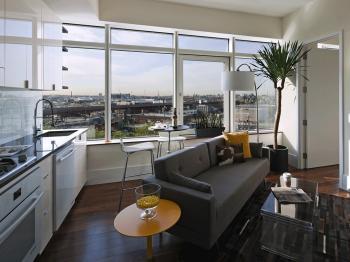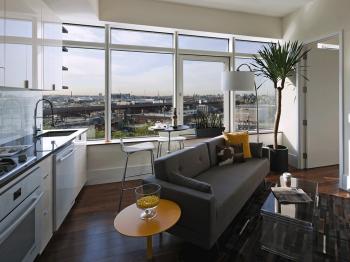Impatient with the pace of architecture, designer Regan Chen upped and moved from Los Angeles last year to start a design business in New York.
He fell in love with the unique character of New York spaces and after a stint designing furniture he and a former colleague decided to start their own business. Olollo was born.
Chen says his new venture is very exciting. The team concentrates mainly on designing and building custom furniture as well delving into some interior design. Named after its launch date (01/01/10—take out the slashes), Olollo is growing rapidly—in part due to a unique approach to design, Chen said.
“We just ask lots of questions [of the client], trying to get into their mindset...to figure out what their character is, how he or she lives and how something can be tailored and sculpted around their whole lifestyle,” Chen said. “That’s what good design really does, it leaves a good aftertaste, it builds a memory. That’s what we start to do with all our projects, be it a small piece of furniture, a side table, or a whole condo.”
He fell in love with the unique character of New York spaces and after a stint designing furniture he and a former colleague decided to start their own business. Olollo was born.
Chen says his new venture is very exciting. The team concentrates mainly on designing and building custom furniture as well delving into some interior design. Named after its launch date (01/01/10—take out the slashes), Olollo is growing rapidly—in part due to a unique approach to design, Chen said.
“We just ask lots of questions [of the client], trying to get into their mindset...to figure out what their character is, how he or she lives and how something can be tailored and sculpted around their whole lifestyle,” Chen said. “That’s what good design really does, it leaves a good aftertaste, it builds a memory. That’s what we start to do with all our projects, be it a small piece of furniture, a side table, or a whole condo.”
Looking at the lifecycle of a particular piece or a space is crucial, Chen said. “We don’t design for a photo shoot because spaces are meant to be lived in; products are meant to be used. And when you factor in the time element it really makes for something much better.”
Chen related good design to restaurants. ”It’s great in the moment, but if someone can remember it to the point where they want to share it with people—that’s the takeaway that we want to create, that’s when something becomes really special,” he said.
“There are tons of restaurants, there are tons of spaces and furniture, but if people don’t have some emotional connection to it, it loses its power. If we’re able to evoke a really strong positive reaction that people can respond to, then that’s the power of great design.”
Launching a new business in a tough economic climate was a bold move for Chen and his team, but it has paid off.
Continued on the next page...
Chen related good design to restaurants. ”It’s great in the moment, but if someone can remember it to the point where they want to share it with people—that’s the takeaway that we want to create, that’s when something becomes really special,” he said.
“There are tons of restaurants, there are tons of spaces and furniture, but if people don’t have some emotional connection to it, it loses its power. If we’re able to evoke a really strong positive reaction that people can respond to, then that’s the power of great design.”
Launching a new business in a tough economic climate was a bold move for Chen and his team, but it has paid off.
Continued on the next page...
“When we started, our friends and families, although they were supportive, thought we were out of our minds. There was a bit of cautious optimism but we also knew, saw, and felt that during this meltdown it was really the bigger companies that were suffering the most. We were really optimistic that since we were small and because we were new, we were able to be much more agile, and much more focused on how we respond to opportunities. I think that’s where our growth came from.”
The most rewarding part of the business for Chen has been the ability to create a portfolio of products and services that are strongly focused on the user experience.
“In the past I’ve worked with companies that overall lacked a sense of warmth,” he said. “When you design a space, you have to get into that customer’s mind frame. How will they actually live in the space? It’s quite intimate, and to be able to offer that level of service, you’re able to dig deeper than just what is at the surface. I find that hugely satisfying and rewarding, really enriching.”
Working within New York’s unique space constraints has proven both challenging and rewarding for Chen. “I come from Los Angeles where there was endless space. There wasn’t a sense of history, or a sense of character of a building that you had to respect and respond to, anything goes, and I just found that to be rather bland and almost empty. I think design works best when it’s challenged by its constraints.”
The most rewarding part of the business for Chen has been the ability to create a portfolio of products and services that are strongly focused on the user experience.
“In the past I’ve worked with companies that overall lacked a sense of warmth,” he said. “When you design a space, you have to get into that customer’s mind frame. How will they actually live in the space? It’s quite intimate, and to be able to offer that level of service, you’re able to dig deeper than just what is at the surface. I find that hugely satisfying and rewarding, really enriching.”
Working within New York’s unique space constraints has proven both challenging and rewarding for Chen. “I come from Los Angeles where there was endless space. There wasn’t a sense of history, or a sense of character of a building that you had to respect and respond to, anything goes, and I just found that to be rather bland and almost empty. I think design works best when it’s challenged by its constraints.”
Take one of Olollo’s most recent projects and what Chen counts among his favorites, One Vernon Jackson—a new condominium development in Long Island City where Chen and his team designed custom furniture as well as completing some of the interior decor.
“We came up with this idea of a multi-functional unit which served as a work space and storage, vertical circulation, and bed all in one. With a very tight space—60 square feet, we were able to loft a bed up. It was a kind of cascading tower of circulation which all blended together; it looked like it was supposed to be part of the room.”
Working on the project was complex, he said, and the team got to wear many hats. “We were able to craft a single user experience that was very rich. Bringing it back to what is the aftertaste that we’re trying to convey. More often than not it’s the richness of something you produce that lives in memory and not just in the present.”
Chen credits Olollo’s success to his team, describing the company culture as very fluid. “We try to foster a sense of sharing and caring and a warmth. At the end of the day, it’s all about people.”
Chen has plans to expand Olollo in the years to come, but at a manageable pace. “We think growth should be somewhat planned but organic at the same time and we need to focus on how and when we grow and not just let the growth manage us.”
“We came up with this idea of a multi-functional unit which served as a work space and storage, vertical circulation, and bed all in one. With a very tight space—60 square feet, we were able to loft a bed up. It was a kind of cascading tower of circulation which all blended together; it looked like it was supposed to be part of the room.”
Working on the project was complex, he said, and the team got to wear many hats. “We were able to craft a single user experience that was very rich. Bringing it back to what is the aftertaste that we’re trying to convey. More often than not it’s the richness of something you produce that lives in memory and not just in the present.”
Chen credits Olollo’s success to his team, describing the company culture as very fluid. “We try to foster a sense of sharing and caring and a warmth. At the end of the day, it’s all about people.”
Chen has plans to expand Olollo in the years to come, but at a manageable pace. “We think growth should be somewhat planned but organic at the same time and we need to focus on how and when we grow and not just let the growth manage us.”











Friends Read Free